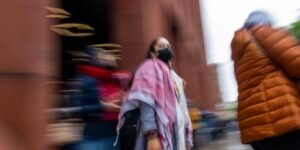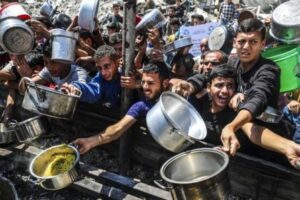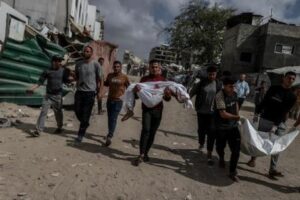Though it has received little coverage in the mainstream U.S. press, there has been ongoing mass protests, along with murderous state repression, in Colombia over the past weeks. The movement is in protest of both an unpopular tax reform introduced by the country’s right-wing president that places the burden of paying for Colombia’s economic crisis, which has been intensified by the pandemic, on the country’s poor and working-class. The protests are also against police violence. This article appeared originally on May 7 in Brecha and was translated by the ISP.
Although the popular protests achieved the withdrawal of an unpopular tax reform, there are still demands that remain unheard. One of the most urgent is the demand against police violence, which has left hundreds of people injured and 37 young people murdered for demonstrating.
Silence cannot settle the pain when listening to Santiago Murillo’s mother cry. “My son, my only son!” she says in a cry that finds no consolation. “They killed me today, let them kill me, because I’m going with my son, I’m going with my son. He was my only son, they killed me today, they shot me too. Where is he? Where is he?” she says in a heartbreaking voice.
Santiago, 19, was a young man from Ibagué, Tolima, in the west of the country, who died after being shot in the chest by a police officer during the ongoing protests in Colombia. The next day, his mother was accompanied by a crowd, two blocks from her home, where her son was killed. Cases like this are the reason for protests in Colombia. Other young people, like Sebastián, do not forget either. In his hands he holds a sign that reads: “Standing up for our dead, not one more minute of silence”. They do not remain silent or succumb to government repression. According to the NGO Temblores, which is in charge of registering cases of police violence in Colombia, from April 28 to May 6, there were 37 people killed, 26 victims of aggression in their eyes, 234 victims of physical violence, 11 victims of sexual violence, 98 cases of gunshots and 934 arbitrary detentions by the State.
Sebastian, like the rest of the protesters, exposes his life to the third peak of coronavirus infections in the country and to the militarization of the cities: President Ivan Duque launched, on May 1, the deployment of the Armed Forces under the guise of “military assistance” to ensure “public order,” which has increased state violence against citizens.
Another of the signs, held by a young man of about 23 years of age, says: “They stole even our fear!”For this reason, among drums and yellow, blue and red banners, different sectors of the population, led by a new generation of social movements, joined the national strike which began on April 28. Thousands of people are today expressing in the streets the generalized discontent for the excessive force and repression against social protest.
Social discontent and misery
In the Plaza de Bolivar, in downtown Bogotá, Sebastian goes out to demonstrate along with thousands of people suffering from unemployment, a problem that in March, the last month for which official figures are available, affected at least 14.2 percent of the total population. Among young people, the situation is worse: even before the pandemic, unemployment among them was 22.5 percent. As the march advances, informal vendors, an occupation that employs tens of thousands of people in the Colombian capital, walk around exhausted looking to make some money to take home to their families. Another group of demonstrators protesting along Seventh Avenue witnesses the grief-stricken faces of people lying on the sidewalks with their suitcases: entire families displaced by violence in other parts of the country.
In addition to the misery and forced displacements common in the country, the pandemic has led to a 6.8 percent drop in GDP, the closure of more than 500,000 small businesses between January and October last year, and a rise in unemployment. Twenty-one million Colombians (42.5 percent of the population) now live in poverty, according to official figures. Faced with such a critical situation, the response of President Duque and former Finance Minister Alberto Carrasquilla was to propose a tax reform they called the Sustainable Solidarity Law. The reform sought to collect close to 23 trillion pesos (about $6 billion) from the pockets of Colombians, through an additional income tax and the imposition of Value Added Tax(VAT) on groceries and basic necessities such as water, electricity, gas, funeral services, Internet, among others on which this tax was not yet levied. The reform also imposed a solidarity tax for high salaries. In total, 73 percent of the money was to be collected from individuals, and the burden would fall mainly on the country’s middle class and the poor.
This situation was the detonator of a social discontent that had been accumulating since much earlier, aggravated in the years of Duque’s government. It was felt in the massive protests of 2019 (see “Noviembre caliente“, “Cómo se cuece el sancocho” and “Lo que permanecíaensilencio“), in which the population protested the government’s failure to follow through on its peace agreement with the FARC guerrillas and against the neoliberal economic model that favors privatization and inequality in the country.
On April 28, Sebastian and thousands of citizens came out to demonstrate against the new tax reform. After long days of protest, the Colombian people achieved the resignation of Minister Alberto Carrasquilla and the withdrawal of the reform planby the Ministry of Finance.However, in the face of repression and serious human rights violations by the state forces and police infiltrators during the protests—as well as the continuation of an official health reform plan widely resisted by workers and businesses of the sector—the National Strike Committee decided to continue the protests.
Encouraging violence
Alejandro Rodríguez Pavón, coordinator of the digital platform GRITA that tracks and publicizes all cases of police violence and provides legal advice to victims, tells Brecha that “in Colombia social mobilization has been growing progressively, but so has repression by the government.” “Today we see not only the Police and ESMAD [Mobile Anti-Riot Squadron] in the streets, but also the military forces. It seems to be normal for a police officer to usetheir firearms against demonstrators. It is really serious,” he added.
On April 30, former President Álvaro Uribe Vélez provoked controversy with a tweet in which he supported “the right of soldiers and police to use weapons to defend their integrity against the criminal action of vandalistic terrorism.” Rodriguez affirms that “these statements have accentuated the violence” and that it is not President Duque who is really in charge, but that he is “obeying orders.” In fact, Duque belongs to the Democratic Center, a party led by Uribe, who is being investigated by the Justice Ministry for his links with paramilitarism (see “La mala hora del parapresidente“).
For Rodriguez, the government’s decision to deploy the military to repress the protests only increases insecurity in the cities, which were already hit by the pandemic and unemployment. On therecent acts of violence, he says: “The local mayors’ offices themselves had not prepared for these anticipated catastrophes, they have actually allowed these types of acts to occur, either by order or by omission. Added to this is the existence of criminal groups and armed civilian populations in peripheral areas of cities such as Cali and Bogotá.”
Criminalization of poverty and protest
The “sucursal del cielo,” as Cali is known, was subjected to a siege in a night of terror that lasted from May 4 to the early hours of May 5. In poor neighborhoods, such as Siloé, residents reported that the police dug in and machine-gunned people, killing five young people and leaving some 33 wounded.
The social explosion that Colombia is experiencing today, besides being caused by state repression and violence, also stems from the criminalization of poverty and social protest in these sections of cities. “The neighborhoods where the situation is most serious are those of the lower classes, where there are young and poor people. Murder rates are highest there,” said Rodriguez. Likewise, during the days of protests in Cali and other cities, the population has reported cuts to power and Internet. “We are concerned about this because it goes against the right to freedom of expression; citizens have the right to use social networks as a mechanism of protest and what we see is that they are being censored, we don’t know if by the Army or by whom,” adds the GRITA coordinator. Various individuals and social movements have also denounced the presence in the streets of police without their badges or IDs and police dressed in civilian clothes, as well as civilians dressed as police to cause confusion in the protests.
In addition to serious human rights violations, in Cali there is a drug trafficking culture that has intensified in recent years, as well as an overflowing migration of those who have fled the war in the southwest of the country. This has accentuated the division between different social sectors and the stigmatization of protest as “vandalism”. This is the case of Ciudad Jardin, a high-income neighborhood in Cali where “its inhabitants went out in several armored vans, a sign of paramilitarism, criminalizing the protesters and telling them, with gun in hand, that they should take care of their neighborhoods and that, if they saw them in theirs, they would take justice into their own hands,” says Rodriguez.
A state that doesn’t care
Sebastian remembers November 25, 2019 as if it were yesterday, when he saw Dilan Cruz, another young man killed by ESMAD, die a few meters away. “He was with a group of 100 or 200 people. A block ahead, we met another group from the march, which was led by a friend waving a giant flag. We hugged each other. We started chanting to onlookers to join us: “¡Amigo mirón, únase al montón!” When we got to the corner of Diecinueve and Quinta, a young woman fainted and, at that moment, we saw when Dilan was killed,” he says with sadness in his eyes. He then points to the Capitol, where the ESMAD is located along with the military and police forces. He says, angrily, “they killed him, they shot him with a compacted aluminum ball, and it was embedded in his head. I saw it. Then we made an altar with stones in homage to Dilan and against police abuse”.
In addition to the government’s rhetoric legitimizing the use of force against “vandals” to justify the abuse of power and state crimes committed against citizens, impunity in cases of police violence has increased. A painful example: after the whole country saw the videos in which an ESMAD agent shot Dilan, the Prosecutor’s Office decided that the case should continue in the military criminal justice system and not in the ordinary justice system. Finally, the investigation by the Prosecutor’s Office ruled that the culprit was the dead man, for “suddenly entering the angle of vision previously established by the shooter.” In addition, to justify his death, the report of the Public Prosecutor’s Office presented a quasi-criminal profile of the young man.
Victor Barrera, political scientist and researcher at the Center for Research and Popular Education, tells Brecha that “there is a cumulative effect of high impunity in cases of systematic violence by agents of the State.”“The processes that have ended in a ruling against the Police are almost null and, therefore, the guilty parties are never identified,” he adds. This situation of exemption from Justice, and the excessive power that the security agencies of the Colombian State have, make it difficult to undertake a structural reform of these forces, such as the one demanded by the young people who are demonstrating today. “In Colombia, there is a very big problem of institutional design, the result of having a police force—which is a civilian body in arms—that is evaluated by its performance as a military force,” explains Barrera.
Molecules and rights
On the other hand, the researcher points out that the current viciousness against the protests is a reaction to the fall in popularity of Uribismo (Duque’s right-wing political bloc allied with paramilitaries and led by Uribe), “which is seeing its continuity threatened for the next elections in 2022.” In January 2018, according to the consulting firm Datexco, Uribe had a favorable image among 45 percent of the population and faced a disapproval of 49 percent. By January 2021, however, his popularity had fallen to 27 percent and disapproval reached 66 percent, unlike what happened with the main candidate of the left, Senator Gustavo Petro, who has seen his popularity remain stable above 40 percent. According to Barrera, the ruling party “tries to plunge the population into a spiral of violence due to the difficulties it has to maintain its influence through democratic procedures: that is why it makes decisions using punitive force.”
In this context, in February, Alexis López, a supposed Chilean scientific researcher visited Colombia to educate the military forces in the management of social protest. In several conferences at the New Granada Military University, López, who defines himself as an “entomologist with studies in journalism, electronics, computer science and classical languages,” exposed what, according to him, is the new conspiratorial model of the Latin American left to take power and end democracy: the “dissipated molecular revolution,” an expression taken from the French philosopher Gilles Deleuze. López became known at the beginning of the century in his native country for founding the openly neo-Nazi and pro-PinochetMovimiento Patria Nueva Sociedad, with which he was able to organize international conferences with other militants of far-right formations. In this regard, a new tweet by Uribe caused controversy in the networks on May 3, when he made four recommendations to face the protests, as if they were a crime and not a legitimate right; among them, “recognize that terrorism is bigger than imagined” and “resist the dissipated molecular revolution.”
So far, Duque has been clear in his support for the use of force “against the vandals.” In his last intervention, he said that he “has designed a strategy against vandalism at the national level” and that he will offer a reward of up to 10 million pesos ($2,600) for finding those who commit disorderly acts. The president’s Human Rights advisor, Nancy Patricia Gutiérrez, told Semana magazine that “human rights only exist if all citizens abide by the obligations we have to be part of society.”
Despite the fact that the Office of the UN High Commissioner for Human Rights and other international bodies have condemned the violence exercised by state forces, the repression continues and has Colombians in a state of anxiety. The deputy director of the Peace and Reconciliation Foundation, Ariel Avila, recently said that the deployment of military forces in the cities is “a terrible risk” since the armed forces are used to fighting with blood and fire against armed groups such as guerrillas and drug traffickers. But, in the face of state violence, protest continues to be the choice of many young people who, like Sebastian, believe in the possibility of change. He, like so many others, is part of a generation that wants peace in Colombia. He is not a vandal or a bum, he is a student with dreams, who knows his rights and wants his future to be framed by empathy and not by violence.



